Abstract
Vitamin A deficiency (VAD) prevalence in Sub‐Saharan Africa is high in spite of vitamin A supplementation programmes among children in most countries. Plant‐based complementary foods remain the key source of nutrients in addition to breast milk for infants in lower income countries. Cereal‐legume blends are superior in protein and energy densities compared with maize, millet or sorghum‐only porridge. However, unfortified cereal‐legume and cereal‐only porridges are low in vitamin A. A household‐level sweet potato‐based infant food, rich in vitamin A, has been developed to complement vitamin A supplementation initiatives in Sub‐Saharan Africa. A composite flour containing sweet potato, soybean, soybean oil and fishmeal was processed as complementary food by oven toasting (denoted oven‐toasted ComFa). The oven‐toasted ComFa and enriched Weanimix (processed from dehulled maize, dehulled soybean, groundnut and fishmeal) were assessed for suitability as complementary food based on the nutrient composition using specifications in the Codex Standard (CS) as a reference. The sweet potato‐based formulation and enriched Weanimix met the energy, protein, fructose and fat specifications but barely met the amino acid score as indicated in the CS. However, only the oven‐toasted ComFa met the calcium and almost half the vitamin A levels as specified in the CS. Oven‐toasted ComFa was slightly lower in energy, protein and fat by a difference not greater than 4.0% but was higher by more than 100% in fructose and vitamin A levels. Therefore, the sweet potato‐based complementary food is likely to support vitamin A supplementation initiatives in low‐income countries better than the cereal‐based formulation.
Keywords: codex standard, fructose, household‐level, soybean, Sub‐Saharan Africa, sweet potato
Introduction
Vitamin A deficiency (VAD) is a worldwide health problem responsible for growth failure and increased susceptibility to infection, blindness and it contributes to anaemia by impairing iron transport and utilization for haemoglobin synthesis [Ross 1998; Administrative Committee on Coordination (ACC) & Sub‐Committee on Nutrition (SCN) 2001]. An estimated 33% of children under 5 years old worldwide have VAD using serum retinol level of <0.70 µmol l−1 as a cut‐off (WHO 2009). In Africa, the prevalence is higher (44%). In Sub‐Saharan Africa, all the countries are in the ‘severe’ degree of VAD severity (defined as prevalence ≥20% among children under 5 years) with the exception of Gabon, Namibia and South Africa (WHO 2009). This is in spite of ongoing vitamin A supplementation programmes with a coverage rate of 67% (full supplementation; child receives two doses per year) to 77% (part supplementation; child receives at least one dose) for children under 5 years in Sub‐Saharan Africa (UNICEF 2009). Poor diet and infection were identified as the main causes of VAD (WHO 2009). The prohibitive cost of nutritionally adequate complementary food available in low‐income countries makes it unaffordable to most resource‐poor households. Cereal‐based complementary foods are low in most vitamins and minerals (Lutter & Rivera 2003) and have low bioavailability but are the key source of nutrients in addition to those in breast milk for most infants in lower income countries (Gibson et al. 2010). The primary ingredient for such foods can either be maize (corn), millet or sorghum, which is low in lysine and energy (Annan & Plahar 1995).
Cereal‐legume blends, processed at the household‐level, are not fortified with mineral or vitamin premix (Gibson et al. 2010); hence, their micronutrient (particularly vitamin A) content is likely to be low and thus contribute to relatively high VAD in low‐income countries where infants are fed such complementary food. In Africa, Weanimix [a composite blend of maize (75%), soybean (15%) and groundnut (peanut) (10%)] is considered to be an adequate household‐level complementary food because it has relatively high energy and protein densities compared with complementary foods from maize, millet or sorghum only (Lartey et al. 1999). However, Weanimix alone is low in many micronutrients particularly in vitamin A [8.3 µg retinol equivalents (RE)/100 kcal] (Lartey et al. 1999) compared with 60 RE/100 kcal, which is the lowest vitamin A level specified in the Codex Standard (CS) (CODEX STAN 074–1981) for foods for infants and young children (Codex Alimentarius Commission 2006). The effect of consumption of this improved household‐level complementary food on vitamin A status among breastfed infants using serum retinol level as an index has been investigated (Lartey et al. 1998). Infants were randomly assigned to Weanimix, Weanimix fortified with vitamin and mineral premix, Weanimix plus fish powder prepared from anchovies (Engraulis hepsetus) or koko (fermented maize only porridge) plus fish powder group. The intervention foods were supplied for a 6‐month period, starting when infants were 6 months of age. At the end of the study, there was a decrease in the serum retinol levels compared with the baseline serum retinol status in all the groups with the exception of those infants assigned to the Weanimix fortified with vitamin and mineral premix. The changes in serum retinol levels were: Weanimix = −0.08 ± 0.3 µmol l−1, Weanimix fortified with vitamin and mineral premix = 0.17 ± 0.34 µmol l−1, Weanimix plus fish powder = −0.01 ± 0.3 µmol l−1 and koko plus fish powder = −0.02 ± 0.3 µmol l−1). These findings suggest appropriate serum retinol levels that would support the growth demands for vitamin A were not met by giving these improved foods unless fortified with vitamin and mineral premix. Despite this, dried composite flours of cereals and legumes served as porridge to infants are currently promoted as complementary food in Sub‐Saharan Africa (Mensa‐Wilmot et al. 2001; Ayoya et al. 2010; Elemo et al. 2011).
Because household‐level complementary foods in Sub‐Saharan Africa are not usually fortified with vitamin and mineral premix due to the cost of such products, there is a need to find alternative food crops that are higher in β‐carotene (precursor for vitamin A) and highly bioavailable. Kapinga et al. (2010) reported that the coloured 1 variety of sweet potato could be a significant dietary source of vitamin A in Sub‐Saharan Africa. Two studies conducted in Sub‐Saharan Africa have demonstrated that consumption of boiled orange‐fleshed sweet potato improved vitamin A status of children and can significantly complement vitamin A supplementation initiatives to minimize VAD (van Jaarsveld et al. 2005; Low et al. 2007). Thus, the coloured sweet potato has the potential to serve as a more sustainable food‐based strategy for controlling VAD in children (van Jaarsveld et al. 2005). β‐carotene from sweet potato is substantially better (in terms of bioavailability) than that from leafy vegetables or other vegetables (Administrative Committee on Coordination (ACC) & Sub‐Committee on Nutrition (SCN) 2001). However, the potential of the coloured‐fleshed sweet potato has not been fully exploited in terms of processing it into a dried complementary food like Weanimix to be prepared as porridge before serving to infants.
Few studies have used sweet potato to prepare a cereal‐like complementary food (Ameny et al. 1994; Akubor 1997, 2005; Ijarotimi & Ashipa 2006; Nandutu & Howell 2009). In product formulation studies, only Nandutu & Howell (2009) used the orange‐fleshed sweet potato variety; the others used the white‐fleshed sweet potato, which is devoid of β‐carotene (van Jaarsveld et al. 2005). We investigated the possibility of developing a non‐cereal based complementary food using cream‐fleshed sweet potato (a variant of the orange‐fleshed sweet potato) using household‐level food processing technologies as a measure to improve the vitamin A content of such foods.
The objective of this study was to assess the suitability of cream‐fleshed sweet potato‐based complementary food and enriched Weanimix (processed from dehulled maize, dehulled soybean, groundnut and fishmeal) using the nutrient composition including vitamin A specifications in the CS (Codex Alimentarius Commission 2006) as a reference. This standard has been created by Food and Agriculture Organization (FAO) and WHO to serve as food standards and guidelines to ensure quality and safety of food worldwide (Zlotkin et al. 2010). The current CS (CODEX STAN 074–1981) covers four categories of cereal‐based foods for infants and young children listed below:
-
1
• cereals for infants (6 months old onwards) to be prepared with milk or other nutritious drinks before consumption;
-
2
• cereals for infants to be prepared with water only or non‐protein liquids before consumption;
-
3
• pasta;
-
4
• rusks and biscuits.
Each category has different nutritional specifications and should have a cereal such as wheat, rice, barley, oats, rye, maize, millet, sorghum or buckwheat as the base ingredient. Legumes, starch stems, oil seeds or starchy roots such as arrow root, yam or cassava may be added in smaller proportions.
Key messages
-
•
Cream‐fleshed sweet potato can be added to soybean to process a cereal‐like complementary food similar to cereal‐legume blends.
-
•
Complementary food formulated from sweet potato and legumes will be sweeter than cereals‐legumes blend because it will be high in fructose.
-
•
Addition of fishmeal prepared from small fish with bones intact improves the calcium content of complementary food at the household level.
-
•
The vitamin A content of cream‐fleshed sweet potato–soybean blend is far higher than the vitamin A content in maize–soybean–groundnut processed as household level complementary food.
Materials and methods
Ingredients for processing the complementary food
All materials used were obtained in New Zealand, except where otherwise stated. Cream‐fleshed sweet potato (Ipomoea batatas) was sourced from Delta Produce Co‐op Ltd. and processed into flour using household‐level processing techniques comprising peeling, dicing, drying and grinding. Full‐fat soybean (Glycine max) flour (Floursoy 25) and soybean oil (AMCO Soya) were purchased from local distributors. Iodized salt and white sugar were purchased from local supermarkets in Palmerston North. Fishmeal prepared from smoked‐dried anchovies (Engraulis hepsetus) was imported from Ghana, West Africa.
The ingredients for Weanimix were refined maize meal (Springbok™, South Africa), soybean seed and groundnut paste. These were obtained from local supermarkets in Palmerston North. The soybean seeds were roasted in an electric frying pan (Kambrook 9708, Hong Kong) until golden brown, dehulled manually and milled into flour.
Processing of complementary foods
Although the vitamin A content of complementary food was part of the basis of this work, we also targeted our formulation to have a protein density between 2.0–5.5 g/100 kcal and energy density of ≥0.8 kcal g−1 as indicated in CS for processed cereal‐based foods for infants and young children (Codex Alimentarius Commission 2006). We employed a computer programme (Nutrition Calculator) developed by Global Alliance for Improved Nutrition (GAIN) (J. Siekmann, personal communication) to obtain the proportions of ingredients needed to get our target for protein and energy values stated above. Based on the GAIN Nutrition Calculator, we developed a formulation with the following proportions of ingredients: sweet potato flour (66%), full‐fat soybean flour (10%), fishmeal (17%), soybean oil (6%), iodized salt (0.5%) and granulated white sugar (0.5%). Fishmeal was included in the formulation as a household‐level strategy to improve protein quality as well as the mineral contents. This composite food blend was mixed in a food mixer (NSF®, ARM‐02, Thunderbird®, Canada). The homogenous composite flour (approximately 2 kg) was toasted in an oven (AR 85, Electrolux, Steelfort Engineering Company Ltd., Palmerston North, New Zealand) at 120°C for 30 min with intermittent stirring (manually) every 5 min. The sample was further dried in a forced‐air oven (Whitlock Speedy Smoke ‘N’ Cooker, Progressive Machinery Design Ltd., Auckland, New Zealand) at 60°C for 48 h. The product obtained was referred to as the oven‐toasted ComFa.
The composition of the maize‐based complementary was the same (75% maize, 15% soybean and 10% groundnut) as reported by Lartey et al. (1999) with slight modifications. Refined (dehulled) maize flour was used instead of roasted unrefined maize flour because white maize grain for human consumption was not available in New Zealand. Dehulled flour instead of non‐dehulled soybean flour was used in the formulation. The composite flour was toasted until golden brown (approximately 20 min) in an electric frying pan (Kambrook 9708, Hong Kong). Fishmeal and granulated white sugar were added in similar proportions as in the oven‐toasted ComFa, which were 17% (w/w) and 0.5% (w/w), respectively. This formulation was referred to as enriched Weanimix.
Nutrient composition analyses
Three samples were taken from each formulation after processing and stored separately in air‐tight plastic containers at −1.0°C in a chiller prior to analyses. The acid hydrolysis method for fat [Association of Official Analytical Chemists (AOAC) 922.06] described by the AOAC International (AOAC 2005) was used for crude fat determination, and the AOAC 925.10 was used for moisture determination. An assay kit (K‐ACHDF 11/08) (Megazyme Int., Wicklow, Ireland) was used to determine the levels of D‐glucose and D‐fructose contents. Carbohydrate was computed as the sum of D‐glucose and D‐fructose. The gross energy content (using bomb calorimetry), retinol and β‐carotene [using High Performance Liquid Chromatography, Carr‐Price method, AOAC 974.29 (4)] and amino acid profile (hydrochloric acid hydrolysis followed by HPLC separation, AOAC 994.12) were performed by the Nutrition Laboratory (Massey University, Palmerston North, New Zealand). The protein content was determined as the sum of the individual amino acids residue (FAO 2003). A conversion factor of 1 RE:12 β‐carotene was used in calculating the vitamin A content of oven‐toasted ComFa as has been used for boiled sweet potato roots (Hagenimana et al. 2001). The amino acid score (chemical score) was calculated using casein as reference protein. Calcium was determined using quadruple inductively coupled plasma mass spectrometry after sample digestion by Campbell Micro Analytical Laboratory, Department of Chemistry, Otago University, New Zealand.
The three samples were all separately analysed for the nutrients mentioned above with the exception of the retinol, β‐carotene and amino acid profile, which were done on two samples because of logistical constraint. The energy and the other nutrient composition data were converted to energy density (kcal g−1) and nutrient density (/100 kcal), respectively, to enable comparison with specifications in the CS (Codex Alimentarius Commission 2006).
Data analysis
The mean and standard deviation were calculated using Minitab v15.1™ (Minitab Inc., State College, PA, USA) and were plotted as bars using SigmaPlot v11.0 (Systat Software, Inc., GmbH, Germany).
Results and discussion
Product description for cereal‐based infant food in the Codex Commission Standard
The oven‐toasted ComFa and enriched Weanimix were designed to be prepared as porridge with water only before consumption. The protein contents of the oven‐toasted ComFa and enriched Weanimix were 4.01 ± 0.12 (mean ± standard deviation) and 4.19 ± 0.12 g/100 kcal, respectively. This protein level places both the oven‐toasted ComFa and enriched Weanimix into the second category CS product definition. Such cereal‐based infant food should have a protein content ranging from 2.0 to 5.5 g/100 kcal and should be processed to be prepared with water only or non‐protein liquids before consumption. For clarity, use of the CS henceforth refers to the standards for cereal‐based complementary food for infants to be prepared with water only or non‐protein liquids before consumption. Based on the proportion of the ingredients used to formulate the oven‐toasted ComFa (see materials and methods section), this sweet potato‐based infant food did not contain cereal as the base ingredient. Thus, the oven‐toasted ComFa should not be compared with the CS as it was established for cereal‐based infant foods (Codex Alimentarius Commission 2006). But in the absence of a suitable standard to assess the suitability of the oven‐toasted ComFa as a complementary food, the CS was used. In contrast, the enriched Weanimix, which contained three times as much maize (cereal) as the combined proportion of soybean and groundnut (legumes), qualifies as cereal‐based complementary food for infants because maize is the base ingredient. The use of the CS also enabled us to compare the nutrient composition including vitamin A in oven‐toasted ComFa and enriched Weanimix as household‐level complementary foods.
Energy density
The energy density of cereal‐based complementary food should be ≥0.8 kcal g−1 (Codex Alimentarius Commission 2006). The oven‐toasted ComFa and enriched Weanimix met the minimum specified energy density in the CS as shown in Fig. 1. Therefore, both formulations will meet the energy required from complementary foods for infants. However, the oven‐toasted ComFa (4.70 ± 0.00 kcal g−1) was lower by a difference of 4.0% compared with level of the enriched Weanimix (4.91 ± 0.01 kcal g−1). The energy level of enriched Weanimix was similar with that indicated for Weanimix (4.4 kcal g−1) in another study (Lartey et al. 1999).
Figure 1.
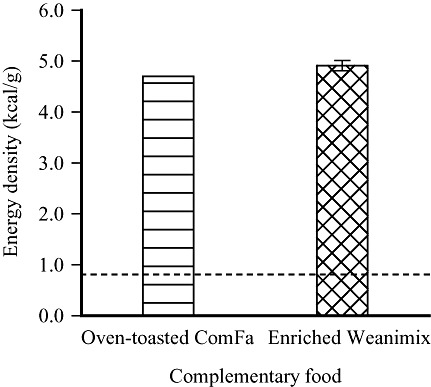
Energy density of household‐level processed complementary foods. Line ( ) represents the minimum level for complementary foods for infants in the Codex Standard. Bar values (means ± standard deviation, n = 3).
) represents the minimum level for complementary foods for infants in the Codex Standard. Bar values (means ± standard deviation, n = 3).
Protein
The protein content of the oven‐toasted ComFa was 4.01 ± 0.12 g/100 kcal and that of enriched Weanimix was 4.19 ± 0.12 g/100 kcal; both were near the upper limit of protein specification (from 2.0 to 5.5 g/100 kcal) in the CS as shown in Fig. 2. However, as shown in Fig. 3, both products barely met the minimum amino acid score (index for protein quality) of at least 80% using casein as the reference protein as specified in the CS (Codex Alimentarius Commission 2006). The amino acid scores of the oven‐toasted ComFa and enriched Weanimix were approximately 79% and 78%, respectively. The oven‐toasted ComFa was lower in protein by a difference of 4% than the enriched Weanimix but was slight higher in amino acid score (1.0%). These data suggest that high protein quantity does not necessarily indicate high protein quality. Because the fishmeal used contributed significantly to the total protein level, we suggest that the proportion could be increased to least 20% as used by Lartey et al. (1999) to increase the amino acid score. However, addition of more fishmeal to this level will accentuate the fishy smell and is likely to have sensory implications, particularly in the case of the oven‐toasted ComFa.
Figure 2.
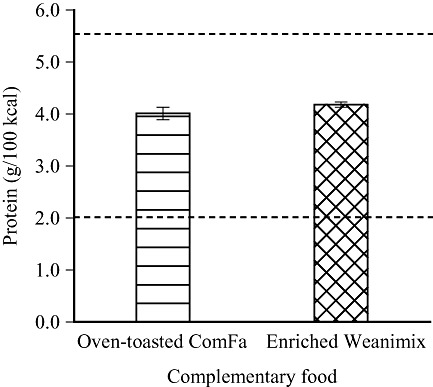
Protein density of household‐level processed complementary foods. Line ( ) represents the minimum and maximum levels for complementary foods for infants in the Codex Standard. Bar values (means ± standard deviation, n = 3).
) represents the minimum and maximum levels for complementary foods for infants in the Codex Standard. Bar values (means ± standard deviation, n = 3).
Figure 3.
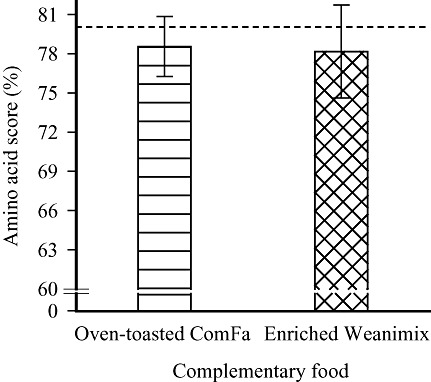
Amino acid score of household‐level processed complementary foods. Line ( ) represents the minimum level for complementary foods for infants in the Codex Standard. Bar values (means ± standard deviation, n = 2).
) represents the minimum level for complementary foods for infants in the Codex Standard. Bar values (means ± standard deviation, n = 2).
Carbohydrate
There is no specification for carbohydrate in the CS for the main ingredients used to prepared cereal‐based complementary food. According to the CS, when sucrose, fructose, glucose, glucose syrup or honey is added to infant food, the amount of carbohydrates from these sources should not exceed 5.0 g/100 kcal (Codex Alimentarius Commission 2006). As shown in Fig. 4, the fructose level of the oven‐toasted ComFa was 1.69 ± 0.06 g/100 kcal, and lower than the value of fructose stipulated in the CS (2.5 g/100 kcal). The fructose content of the oven‐toasted ComFa was higher by a difference greater than 100% compared with enriched Weanimix (0.29 ± 0.02 g/100 kcal). The sweet potato used in our formulation contributed significantly to the fructose content and could be responsible for the sweetness of sweet potato‐based food products. The high fructose level in sweet potato‐based formulation compared with enriched Weanimix is likely to impart sweetness when prepared for consumption reducing the need for additional sugar for sweetening. Hence, the cost of sugar is likely to be reduced when our proposed formulation is promoted and accepted by mothers as household‐level complementary food in low‐income countries. Furthermore, the higher fructose content in the oven‐toast ComFa can be seen as a nutritional advantage over enriched Weanimix because it would result in higher food intake by infants as it has been reported that the level of sweetness of complementary food increased the quantity of product consumed (Dewey & Brown 2003). As shown in Fig. 5, the carbohydrate (as the sum of the measured glucose and fructose contents) in the oven‐toasted ComFa was 12.77 ± 0.32 g/100 kcal, and lower by a difference of 7.7% compared with the level of enriched Weanimix (14.93 ± 0.67 g/100 kcal). The lower glucose content of the oven‐toasted ComFa by a difference of 2.8% compared with level of enriched Weanimix is an indication of less starch content in the oven‐toasted ComFa. Most starch granules are polymers of D‐glucose units and thickens when mixed with water and heat is applied (BeMiller & Huber 2008). Enriched Weanimix is therefore likely to form more viscous porridge than the oven‐toasted ComFa because of its high starch content when is prepared as porridge for consumption and will required dilution with water to reduce the viscosity (Mensah & Tomkins 2003). Reducing the viscosity to a consistency that an infant will be able to consume will lead to dilution of nutrients; therefore, the quantity of nutrient intake will be reduced. The high glucose content in enriched Weanimix contributing to the higher carbohydrate than the oven‐toasted ComFa is not of any nutritional significance as both complementary food formulations did not widely vary in energy as previously discussed.
Figure 4.

Fructose density of household‐level processed complementary foods. Line ( ) represents the maximum level if fructose is added as an ingredient to complementary foods for infants in the Codex Standard. Bar values (means ± standard deviation, n = 3).
) represents the maximum level if fructose is added as an ingredient to complementary foods for infants in the Codex Standard. Bar values (means ± standard deviation, n = 3).
Figure 5.
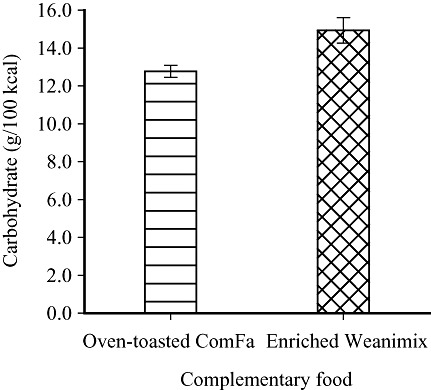
Carbohydrate (glucose + fructose contents) density of household‐level processed complementary foods. Bar values (means ± standard deviation, n = 3).
Lipids
Both the oven‐toasted ComFa and enriched Weanimix had fat at levels not exceeding the maximum level stipulated in the CS (4.5 g/100 kcal)(Codex Alimentarius Commission 2006). The difference between the oven‐toasted ComFa (2.27 ± 0.02 g/100 kcal) and enriched Weanimix (2.29 ± 0.06 g/100 kcal) was below 1.0% (Fig. 6).
Figure 6.
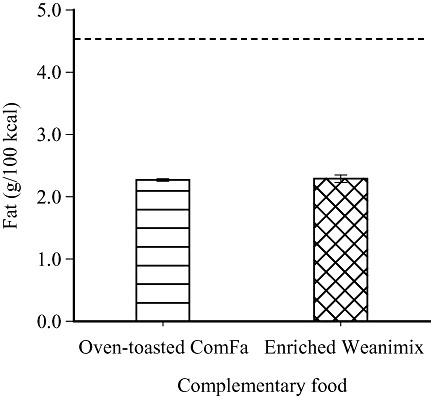
Fat density of household‐level processed complementary foods. Line ( ) represents the maximum level for complementary foods for infants in the Codex Standard. Bar values (means ± standard deviation, n = 3).
) represents the maximum level for complementary foods for infants in the Codex Standard. Bar values (means ± standard deviation, n = 3).
Using the CS specifications for protein, energy and lipid, the oven‐toasted ComFa and enriched Weanimix met the requirements of infant foods to be prepared with water only or non‐protein liquids before consumption.
Calcium
As shown in Fig. 7, the oven‐toasted ComFa met the minimum calcium specification of 80 mg/100 kcal in the CS (Codex Alimentarius Commission 2006). The calcium content of the enriched Weanimix was 6.0% lower than the minimum stipulated value in the CS. The oven‐toasted ComFa was higher in calcium by a difference of 52% than the enriched Weanimix, despite the two formulations having similar amounts of fishmeal incorporated. In Ghana, West Africa, anchovies are eaten with the bones intact (Lartey et al. 1999), which provides a source of calcium. The fishmeal prepared from smoked‐dried anchovies is cheaper and a more readily available source of calcium for resource‐poor households in low‐income countries. The calcium in small fish eaten with bones has been reported to have similar bioavailability as calcium from milk (Hansen et al. 1998). Therefore, localities with access to anchovies should be encouraged to use fishmeal as it is a good source of calcium needed by the growing infant.
Figure 7.
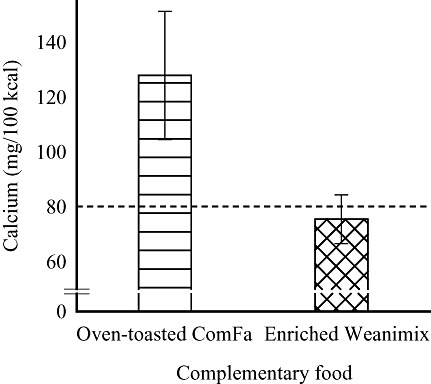
Calcium density of household‐level processed complementary foods. Line ( ) represents the minimum level for complementary foods for infants in the Codex Standard. Bar values (means ± standard deviation, n = 3).
) represents the minimum level for complementary foods for infants in the Codex Standard. Bar values (means ± standard deviation, n = 3).
Vitamin A
According to the CS, vitamin A added to cereal‐based complementary foods for infants should be between 60 µg and 180 µg RE/100 kcal. A typical unfortified maize‐based complementary food such as enriched Weanimix had a vitamin A density of 1.52 µg RE/100 kcal (Fig. 8), which is far below the minimum stipulated value in the CS. Conversely, ComFa had a vitamin A density of 28.04 ± 1.08 RE/100 kcal; about 50% of the minimum vitamin A specification in the CS for cereal‐based complementary food fortified with vitamin A premix. The vitamin A level (not added as a fortifier) in oven‐toasted ComFa was higher than enriched Weanimix by a difference greater than 100%. Therefore, the level in the oven‐toasted ComFa is likely to support ongoing initiatives to reduce VAD better than unfortified cereal‐based complementary food. In addition, it has been shown in previous intervention trials that consumption of orange‐fleshed sweet potato improves vitamin A status of infants (van Jaarsveld et al. 2005; Low et al. 2007). Also, it has been reported that the β‐carotene from sweet potato is substantially bioavailable (Administrative Committee on Coordination (ACC) & Sub‐Committee on Nutrition (SCN) 2001).
Figure 8.
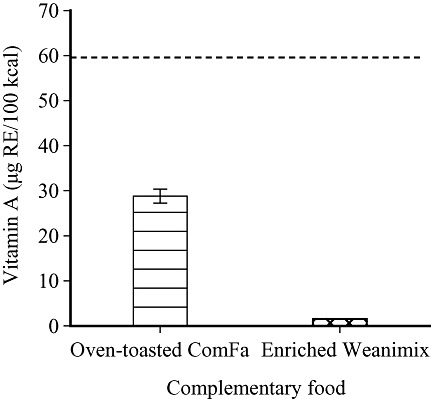
Vitamin A density of household‐level processed complementary foods. Line ( ) represents the minimum level for complementary foods for infants in the Codex Standard. Bar values (means ± standard deviation, n = 2). RE, retinol equivalents.
) represents the minimum level for complementary foods for infants in the Codex Standard. Bar values (means ± standard deviation, n = 2). RE, retinol equivalents.
To the best of our knowledge, our work is the first to report on the vitamin A content of sweet potato‐based cereal‐like complementary food. Our findings support earlier suggestions that coloured‐fleshed varieties of sweet potato will be a long‐term sustainable food‐based approach to reduce VAD in low‐income countries (van Jaarsveld et al. 2005; Low et al. 2007).
Conclusion
The energy, protein and fat densities in oven‐toasted ComFa and enriched Weanimix met the specification in the CS for infant foods to be prepared with water only or non‐protein liquids before consumption. However, the level of amino acid scores in both the oven‐toasted ComFa and enriched Weanimix were slightly lower than the stipulated level in the CS. The oven‐toasted ComFa had significant levels of fructose, calcium and vitamin A using CS specifications compared with enriched Weanimix. The high fructose, calcium and vitamin A contents in the oven‐toasted ComFa make sweet potato‐based complementary food superior as a household‐level food for infant feeding.
Source of funding
The study was funded by the Nutricia Research Foundation, the Netherlands. Project number: 2011‐30.
Conflicts of interest
The authors declare that they have no conflicts of interest.
Contributions
FKA and JC designed the research. FKA conducted the research, analyzed the data and wrote the initial draft. AH, ANM, JLW, LB and JC reviewed the initial draft for intellectual content. All authors read, commented and approved the final version of the manuscript.
Acknowledgements
We thank New Zealand's International Aid and Development Agency for providing FKA with a Commonwealth PhD scholarship. We acknowledge Delta Produce Co‐op Ltd., Dargaville, New Zealand for providing the sweet potato used in this study.
Footnotes
Referred to sweet potato varieties with orange‐, red‐ or cream‐fleshed, but not the white‐fleshed variety, which are rich in β‐carotene, a precursor for vitamin A. Orange‐fleshed variety has been reported to be highly acceptable by children and women in Sub‐Saharan Africa.
References
- Administrative Committee on Coordination (ACC) & Sub‐Committee on Nutrition (SCN) (2001) What works? A review of the efficacy and effectiveness of nutrition interventions In: ACC/SCN: Geneva in Collaboration with the Asian Development Bank, Manila (eds Allen L.H. & Gillespie S.R.), pp 1–67. Asian Development Bank: Manila. [Google Scholar]
- Akubor P.I. (1997) Proximate composition and selected functional properties of African breadfruit and sweet potato flour blends. Plant Foods for Human Nutrition 51, 53–60. [DOI] [PubMed] [Google Scholar]
- Akubor P.I. (2005) Evaluation of physico‐chemical and sensory qualities of African breadfruit and sweet potato based supplementary foods. Journal of Food Science and Technology-Mysore 42, 292–296. [Google Scholar]
- Ameny M.A., Wilson P.W. & Hegsted M. (1994) Protein quality of weaning baby food from African white fleshed sweetpotato varieties and Apios americana with pigeon peas added as a complementary protein. Nutrition Research 14, 1397–1406. [Google Scholar]
- Annan N.T. & Plahar W.A. (1995) Development and quality evaluation of a soy‐fortified Ghanaian weaning food. Food and Nutrition Bulletin 16, 263–269. [Google Scholar]
- AOAC (2005) Official Methods of Analysis of AOAC International. AOAC International: Gaithersburg, MD, Washington, DC. [Google Scholar]
- Ayoya M.A., Kodio J., Iknane A.A. & Sodjinou R. (2010) Nutritional value of locally produced foods and potential for developing age‐appropriate complementary foods for children under 2 years of age in Mali. Food and Nutrition Bulletin 31, 391–399. [DOI] [PubMed] [Google Scholar]
- BeMiller J.N. & Huber K.C. (2008) Carbohydrates In: Fennema's Food Chemistry (eds Damodaran S, Parkin KL. & Fennema OR.), 4th edn, pp 83–151. CRC/Taylor & Francis: Boca Raton, FL. [Google Scholar]
- Codex Alimentarius Commission (2006) Codex standard for processed cereal‐based foods for infants and young children Codex Standards (No. CODEX STAN 074 – 1981, Rev. 1‐2006), pp 1–9. Codex Alimentarius Commission: Rome. [Google Scholar]
- Dewey K.G. & Brown K.H. (2003) Update on technical issues concerning complementary feeding of young children in developing countries and implications for intervention programs. Food and Nutrition Bulletin 24, 5–28. [DOI] [PubMed] [Google Scholar]
- Elemo G.N., Elemo B.O. & Okafor J.N.C. (2011) Preparation and nutritional composition of a weaning food formulated from germinated sorghum (Sorghum bicolor) and steamed cooked cowpea (Vigna unguiculata Walp.). American Journal of Food Technology 6, 413–421. [Google Scholar]
- FAO (2003) Food energy‐methods of analysis and conversion factors Food and Nutrition Paper 77, pp 1–57. Food and Agriculture Organization of the United Nations: Rome. [Google Scholar]
- Gibson R.S., Bailey K.B., Gibbs M. & Ferguson E.L. (2010) A review of phytate, iron, zinc, and calcium concentrations in plant‐based complementary foods used in low‐income countries and implications for bioavailability. Food and Nutrition Bulletin 31, S134–S146. [DOI] [PubMed] [Google Scholar]
- Hagenimana V., Low J., Anyango M., Kurz K., Gichuki S.T. & Kabira J. (2001) Enhancing vitamin A intake in young children in Western Kenya: orange‐fleshed sweet potatoes and women farmers can serve as key entry points. Food and Nutrition Bulletin 22, 376–387. [Google Scholar]
- Hansen M., Thilsted S.H., Sandström B., Kongsbak K., Larsen T., Jensen M. et al (1998) Calcium absorption from small soft‐boned fish. Journal of Trace Elements in Medicine and Biology 12, 148–154. [DOI] [PubMed] [Google Scholar]
- Ijarotimi O.S. & Ashipa F. (2006) Evaluation of nutritional composition, sensory and physical property of home processed weaning food based on low cost locally available food materials. Nutrition and Food Science 36, 6–17. [Google Scholar]
- van Jaarsveld P.J., Faber M., Tanumihardjo S.A., Nestel P., Lombard C.J. & Benade A.J.S. (2005) beta‐Carotene‐rich orange‐fleshed sweet potato improves the vitamin A status of primary school children assessed with the modified‐relative‐dose‐response test. American Journal of Clinical Nutrition 81, 1080–1087. [DOI] [PubMed] [Google Scholar]
- Kapinga R.E., Tumwegamire S., Ndunguru J., Andrade M., Agili S., Mwanga R.O.M. et al (2010) Catalogue of Orange‐Fleshed Sweetpotato Varieties for Sub‐Saharan Africa. International Potato Center (CIP): Lima. [Google Scholar]
- Lartey A., Manu A., Brown K.H., Peerson J.M. & Dewey K.G. (1998) Vitamin A status of Ghanaian breast‐fed infants 6‐12 months fed improved complementary foods. FASEB Journal 12, A648. [Google Scholar]
- Lartey A., Manu A., Brown K.H., Peerson J.M. & Dewey K.G. (1999) A randomized, community‐based trial of the effects of improved, centrally processed complementary foods on growth and micronutrient status of Ghanaian infants from 6 to 12 mo of age. American Journal of Clinical Nutrition 70, 391–404. [DOI] [PubMed] [Google Scholar]
- Low J.W., Arimond M., Osman N., Cunguara B., Zano F. & Tschirley D. (2007) Food‐based approach introducing orange‐fleshed sweet potatoes increased vitamin A intake and serum retinol concentrations in young children in rural Mozambique. Journal of Nutrition 137, 1320–1327. [DOI] [PubMed] [Google Scholar]
- Lutter C.K. & Rivera J.A. (2003) Nutritional status of infants and young children and characteristics of their diets. Journal of Nutrition 133, 2941S–2949S. [DOI] [PubMed] [Google Scholar]
- Mensah P. & Tomkins A. (2003) Household‐level technologies to improve the availability and preparation of adequate and safe complementary foods. Food and Nutrition Bulletin 24, 104–125. [DOI] [PubMed] [Google Scholar]
- Mensa‐Wilmot Y., Phillips R.D. & Sefa‐Dedeh S. (2001) Acceptability of extrusion cooked cereal/legume weaning food supplements to Ghanaian mothers. International Journal of Food Sciences and Nutrition 52, 83–90. [PubMed] [Google Scholar]
- Nandutu A.M. & Howell N.K. (2009) Nutritional and rheological properties of sweet potato based infant food and its preservation using antioxidants. African Journal of Food, Agriculture, Nutrition & Development 9, 1076–1090. [Google Scholar]
- Ross D.A. (1998) Vitamin A and public health: challenges for the next decade. Proceedings of the Nutrition Society 57, 159–165. [DOI] [PubMed] [Google Scholar]
- UNICEF (2009) The State of the World's Children 2009: Maternal and Newborn Health. United Nations Children's Fund (UNICEF): New York. [Google Scholar]
- WHO (2009) Global Prevalence of Vitamin A Deficiency in Populations at Risk 1995–2005: WHO Global Database on Vitamin A Deficiency. WHO Press: Geneva. [Google Scholar]
- Zlotkin S., Siekmann J., Lartey A. & Yang Z.Y. (2010) The role of the Codex Alimentarius process in support of new products to enhance the nutritional health of infants and young children. Food and Nutrition Bulletin 31, S128–S133. [DOI] [PubMed] [Google Scholar]


